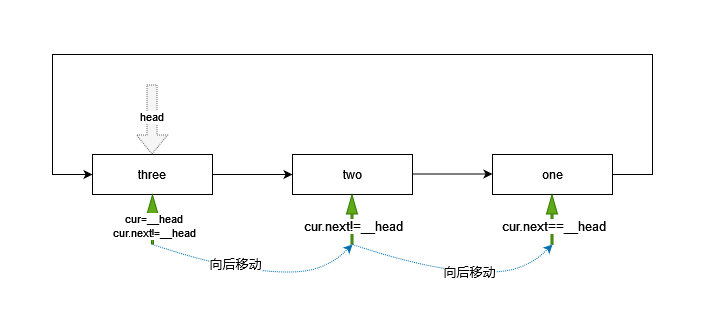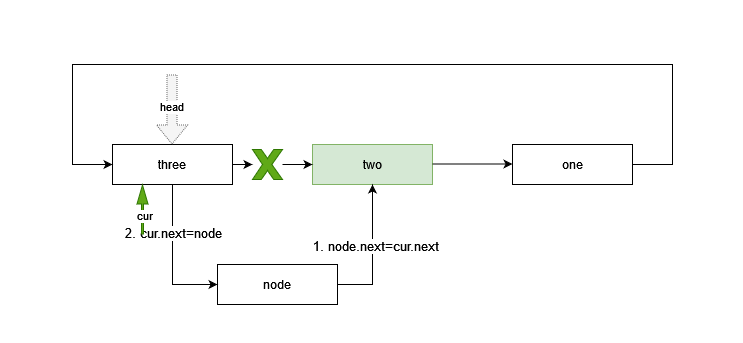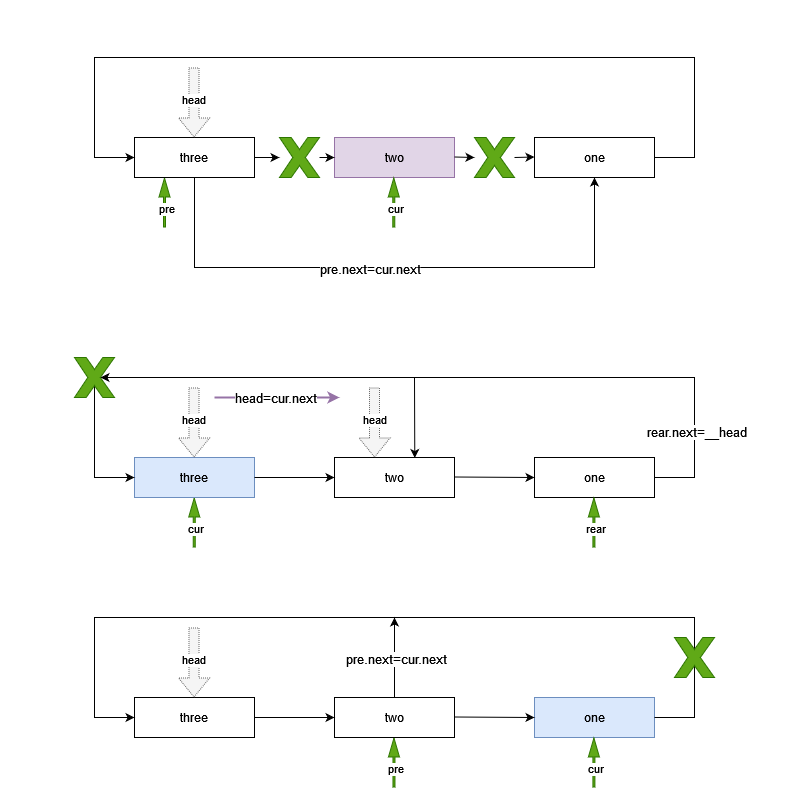Python单向循环链表
单向循环链表与单向链表类似,在操作上,最主要的区别在于判断链表结束的方式.
- 单链表结束,游标cur或next的值为None
- 循环链表结束,游标cur或next值为__head,即指向头部指针
- 这就导致遍历、插入、删除判断条件不同
学习本节请先阅读上一节:Python单向链表
一、节点及链表定义
循环链表的与单向链表相同
- 节点定义
class LinkNode: def __init__(self, val): self.item = val self.next = None - 链表定义
class CycleLinkList: def __init__(self): self.__head: LinkNode = None
二、链表遍历

注意这里while循环结束方式,是与单链表最大的区别之一.
while cur.next != self.__head:,此时游标cur指向最后一个节点,但尚未输出,因此循环结束后,需要输出最后一个元素,即print(cur.item)
def travel(self):
if self.is_empty():
print("linklist id empty")
return
cur = self.__head
while cur.next != self.__head:
print(cur.item, end=" ")
cur = cur.next
# 此时cur位于最后一个节点,他的next指向__head,但是在while循环中并未打印
print(cur.item)
三、链表查找
这里与循环链表的遍历travel类似,while循环结束后,最后一个节点在while中未进行比较,需要在循环外进行比较操作
if cur.item==val:
def search(self,val):
if self.is_empty():
return False
cur=self.__head
while cur.next!=self.__head:
if cur.item==val:
return True
cur=cur.next
if cur.item==val:
return True
return False
四、链表插入节点
循环链表的插入与单链表类似,同样需要考虑三种情况:头部插入,尾部插入,中间插入
- 循环链表首尾相连,头部插入和尾部插入,貌似都是在最后面插入一个节点,但是头部插入需要移动head指针,而尾部插入无须移动head指针
- 中间插入与单链表相同
- 头部插入

- 先将游标cur移动至尾部;
- 将新节点指向头部
- 将游标cur指向新节点
- 移动head指针指向新节点
def addHead(self, val):
node = LinkNode(val)
# 链表为空,head指向node,同时node指向自己
if self.is_empty():
self.__head = node
node.next = node
cur = self.__head
while cur.next != self.__head:
cur = cur.next
node.next = self.__head
# 下面两个顺序没有先后
cur.next = node
self.__head = node
- 尾部插入

尾部插入节点与单链表基本相同:
- 将游标cur移动到链表尾部
- 将尾部指向新节点:cur的next指向node
- 将新节点指向链表头部
def addTail(self,val):
node=LinkNode(val)
if self.is_empty():
self.__head=node
node.next=node
cur=self.__head
while cur.next!=self.__head:
cur=cur.next
# node节点链接首尾,head位置不变,这里与在头部插入不同
cur.next=node
node.next=self.__head
- 中间插入

中间插入与单链表基本相同
def insert(self,pos,val):
if pos<=0:
self.addHead(val)
elif pos>=self.length():
self.addTail(val)
else:
node = LinkNode(val)
cur=self.__head
count=0
while count<(pos-1):
count+=1
cur=cur.next
node.next=cur.next
cur.next=node
五、链表删除节点

循环链表的删除应该是操作最复杂的功能,需要对三种情况进行逐一理解:
- 头部删除:如果删除元素在链表头部,需要另定义一个游标rear循环至链表尾部,然后将头部head向后移,将rear指向head
- 中间删除:中间删除与单链表类似,不做介绍,同单链表的处理,设置2个游标:pre和cur
- 尾部删除:循环链表的while循环结束后,游标cur在尾部,但没有在while循环中进行处理,因此当查找元素在尾部时,跳出循环后需要单独处理.同时要考虑当链表只有一个节点时,while循环时没有执行的,因此也需要在这里处理.
def remove(self,val):
cur=self.__head
pre=None
if self.is_empty():
return False
while cur.next!=self.__head:
if cur.item==val:
# 如果需要删除的元素是在头部,则需要再定义一个游标变量rear,循环至尾部,然后让head指向下一个元素,让
if cur==self.__head:
rear=self.__head
while rear.next!=self.__head:
rear=rear.next
# 由于头部节点已经删除,需要将head向后移动一位,并将尾部(rear)指向新的头部
self.__head=cur.next
rear.next=self.__head
else:
pre.next=cur.next
return True
else:
pre=cur
cur=cur.next
# 跳出循环后,cur位于链表尾部,开始比较尾部是否为要删除数据
if cur.item==val:
# 判断链表是否只有一个元素,即cur==__head
if cur==self.__head:
self.__head=None
else:
pre.next=cur.next
return True
# 没有找到元素,返回False
return False
六、其他功能函数
- 判断链表为空
此处同单链表操作,判断头部指针即可
def is_empty(self):
return self.__head is None
- 计算链表长度
这里需要注意的是,count从1开始计数,由于前面已经判断链表是否为空None 且while循环判断条件与单链表不同,当只有一个节点时,while循环未启动;当游标cur到最后一个节点时,count在while循环也为+1,所以count计数从1开始.
def length(self):
if self.is_empty():
return 0
cur = self.__head
# 这里count的从1开始,注意while循环的终止条件,此时cur到最后一个元素即跳出循环,而count没有即会+1
count = 1
# 游标又回到头部节点,即链表遍历完毕,返回链表长度
while cur.next != self.__head:
count += 1
cur = cur.next
return count
七、完整代码
class LinkNode:
def __init__(self, val):
self.item = val
self.next = None
class CycleLinkList:
def __init__(self):
self.__head: LinkNode = None
def is_empty(self):
return self.__head is None
def length(self):
if self.is_empty():
return 0
cur = self.__head
# 这里count的从1开始,注意while循环的终止条件,此时cur到最后一个元素即跳出循环,而count没有即会+1
count = 1
# 游标又回到头部节点,即链表遍历完毕,返回链表长度
while cur.next != self.__head:
count += 1
cur = cur.next
return count
def travel(self):
if self.is_empty():
print("linklist id empty")
return
cur = self.__head
while cur.next != self.__head:
print(cur.item, end=" ")
cur = cur.next
# 此时cur位于最后一个节点,他的next指向__head,但是在while循环中并未打印
print(cur.item)
def search(self,val):
if self.is_empty():
return False
cur=self.__head
while cur.next!=self.__head:
if cur.item==val:
return True
cur=cur.next
if cur.item==val:
return True
return False
def addHead(self, val):
node = LinkNode(val)
# 链表为空,head指向node,同时node指向自己
if self.is_empty():
self.__head = node
node.next = node
cur = self.__head
while cur.next != self.__head:
cur = cur.next
node.next = self.__head
# 下面两个顺序没有先后
cur.next = node
self.__head = node
def addTail(self,val):
node=LinkNode(val)
if self.is_empty():
self.__head=node
node.next=node
cur=self.__head
while cur.next!=self.__head:
cur=cur.next
# node节点链接首尾,head位置不变,这里与在头部插入不同
cur.next=node
node.next=self.__head
def insert(self,pos,val):
if pos<=0:
self.addHead(val)
elif pos>=self.length():
self.addTail(val)
else:
node = LinkNode(val)
cur=self.__head
count=0
while count<(pos-1):
count+=1
cur=cur.next
node.next=cur.next
cur.next=node
def remove(self,val):
cur=self.__head
pre=None
if self.is_empty():
return False
while cur.next!=self.__head:
if cur.item==val:
# 如果需要删除的元素是在头部,则需要再定义一个游标变量rear,循环至尾部,然后让head指向下一个元素,让
if cur==self.__head:
rear=self.__head
while rear.next!=self.__head:
rear=rear.next
# 由于头部节点已经删除,需要将head向后移动一位,并将尾部(rear)指向新的头部
self.__head=cur.next
rear.next=self.__head
else:
pre.next=cur.next
return True
else:
pre=cur
cur=cur.next
# 跳出循环后,cur位于链表尾部,开始比较尾部是否为要删除数据
if cur.item==val:
# 判断链表是否只有一个元素,即cur==__head
if cur==self.__head:
self.__head=None
else:
pre.next=cur.next
return True
# 没有找到元素,返回False
return False